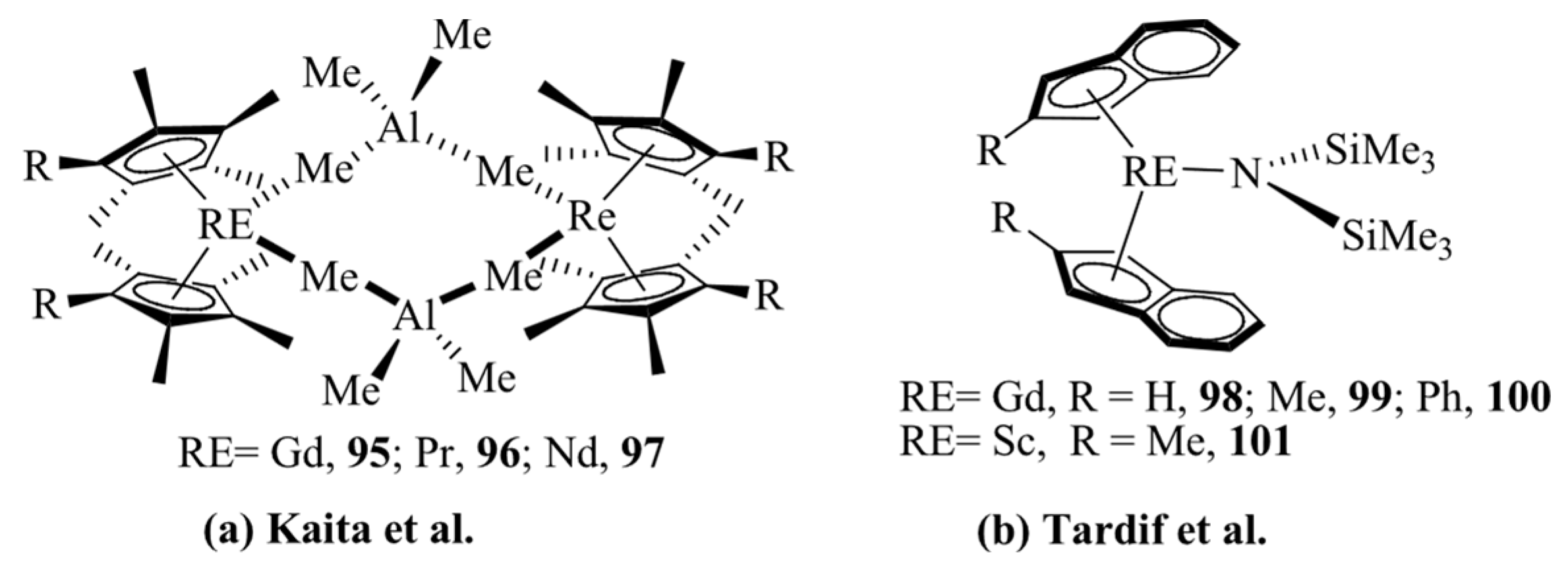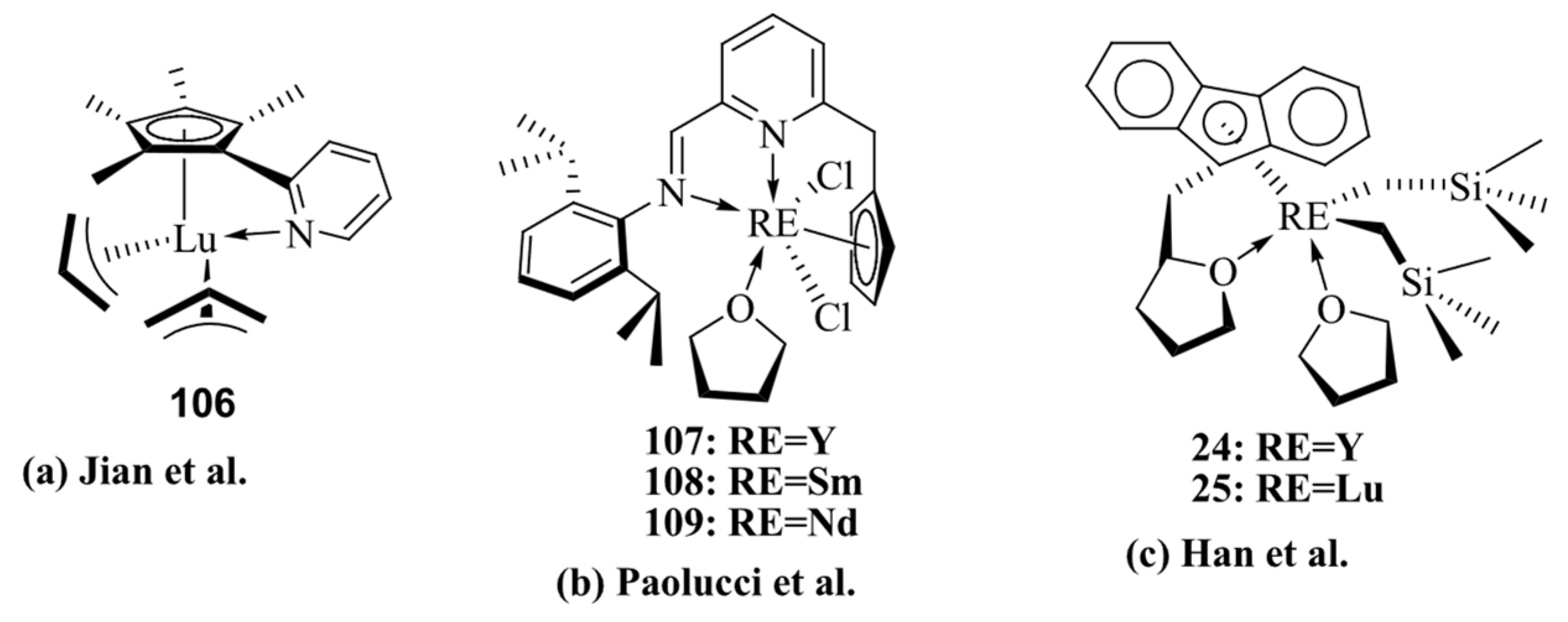Advances in Half-Sandwich Rare-Earth Catalysts for Conjugated Dienes Polymerization
Abstract
1. Introduction
2. Development of Half-Sandwich Rare-Earth Catalysts
3. Catalytic Polymerization of Isoprene
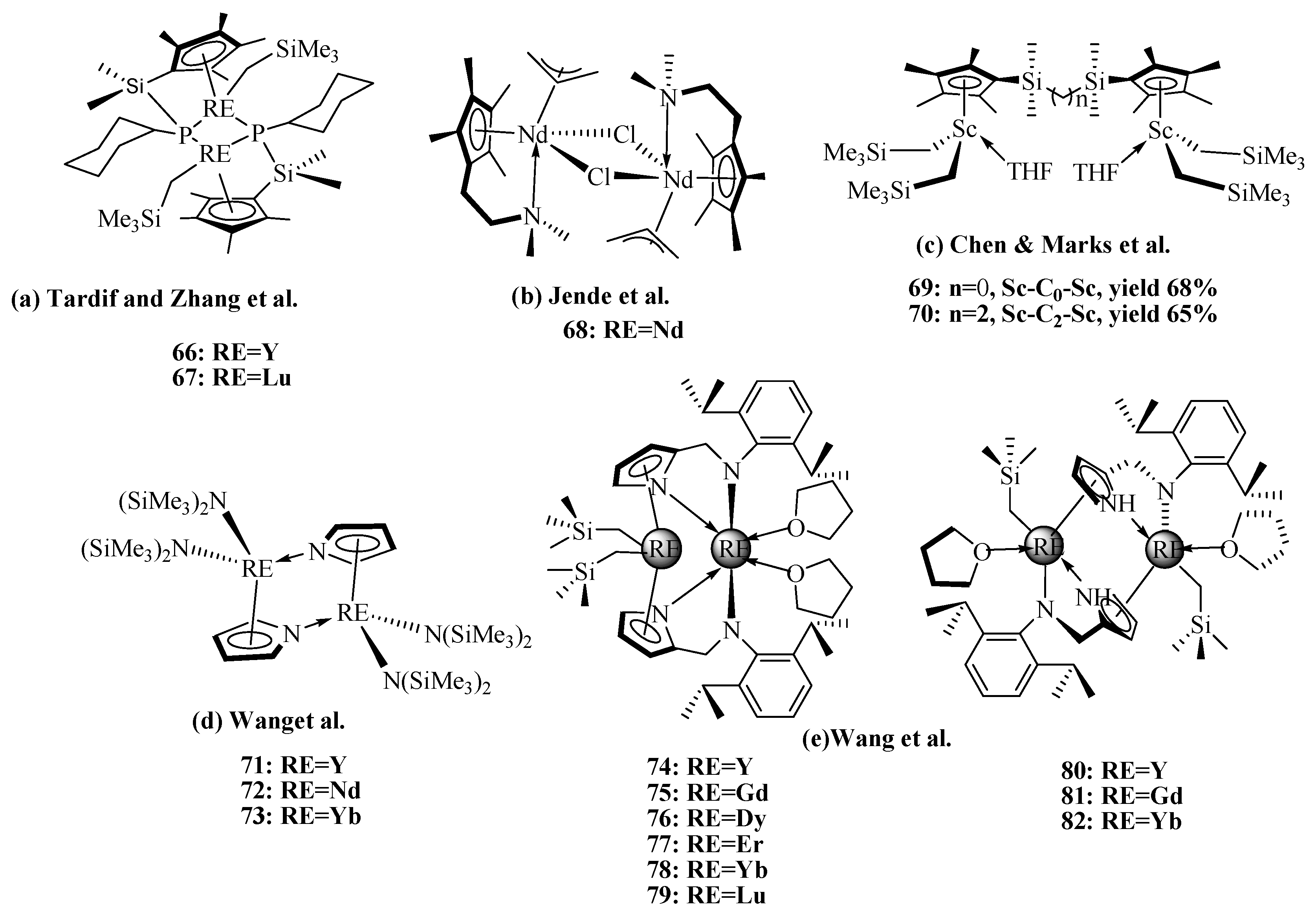
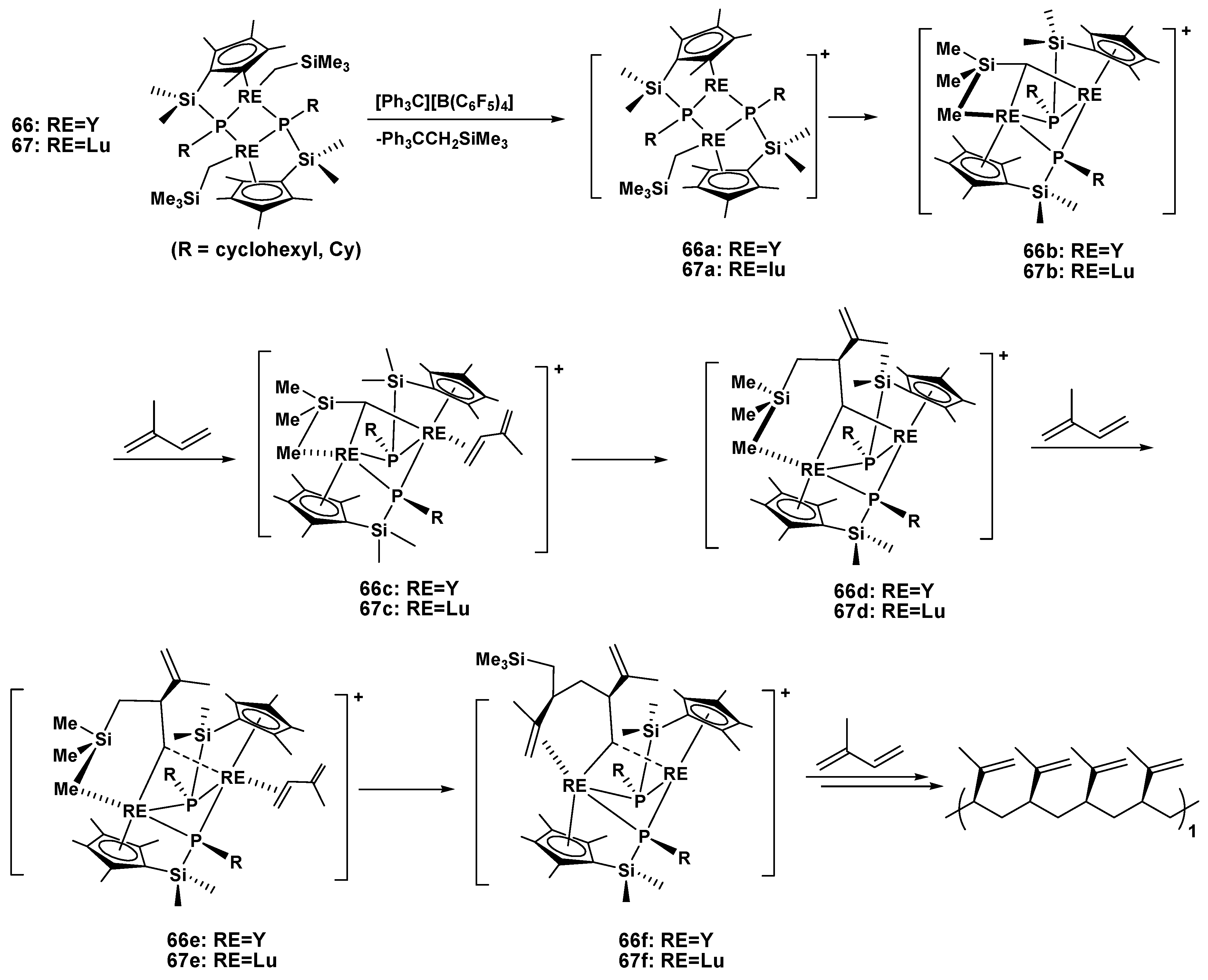
4. Catalytic Polymerization of Butadiene
5. Conclusions and Outlook
Author Contributions
Funding
Data Availability Statement
Acknowledgments
Conflicts of Interest
References
- Halasa, A.F.; Massie, J.M. Polybutadiene. In Kirk-Othmer Encyclopedia of Chemical Technology; Wiley: Hoboken, NJ, USA, 2000. [Google Scholar] [CrossRef]
- Iwayanagi, S.; Sakurai, I.; Sakurai, T.; Seto, T. X-ray structure analysis of trans-1, 4-polybutadiene. J. Macromol. Sci. Part B Phys. 1968, 2, 163–177. [Google Scholar] [CrossRef]
- Kumar, A.; Mohanty, S.; Gupta, V.K. Butadiene rubber: Synthesis, microstructure, and role of Catalysts. Rubber Chem. Technol. 2021, 94, 393–409. [Google Scholar] [CrossRef]
- Zhao, M.; Ma, Y.; Zhang, X.; Wang, L.; Zhu, G.; Wang, Q. Synthesis, characterization and catalytic property studies for isoprene polymerization of iron complexes bearing unionized pyridine-oxime ligands. Polymers 2022, 14, 3612. [Google Scholar] [CrossRef] [PubMed]
- Pan, Y.; Xu, T.; Yang, G.-W.; Jin, K.; Lu, X.-B. Bis (oxazolinyl) phenyl-ligated rare-earth-metal complexes: Highly regioselective catalysts for cis-1, 4-polymerization of isoprene. Inorg. Chem. 2013, 52, 2802–2808. [Google Scholar] [CrossRef]
- Yang, D.; Gan, Q.; Chen, H.; Ying, W.; Zhao, J.; Jia, X.; Gong, D. Polymerization of conjugated dienes and olefins promoted by cobalt complexes supported by phosphine oxide ligands. Inorganica Chim. Acta 2019, 496, 119046. [Google Scholar] [CrossRef]
- Zhao, J.; Chen, H.; Li, W.; Jia, X.; Zhang, X.; Gong, D. Polymerization of isoprene promoted by aminophosphine (ory)-fused bipyridine cobalt complexes: Precise control of molecular weight and cis-1, 4-alt-3, 4 sequence. Inorg. Chem. 2018, 57, 4088–4097. [Google Scholar] [CrossRef]
- Annunziata, L.; Pragliola, S.; Pappalardo, D.; Tedesco, C.; Pellecchia, C. New (anilidomethyl) pyridine titanium (IV) and zirconium (IV) catalyst precursors for the highly chemo-and stereoselective cis-1,4-polymerization of 1, 3-butadiene. Macromolecules 2011, 44, 1934–1941. [Google Scholar] [CrossRef]
- Ricci, G.; Leone, G.; Boglia, A.; Masi, F.; Sommazzi, A. Cobalt: Characteristics, Compounds, and Applications; Vidmar, L.J., Ed.; Nova Science: Hauppauge, NY, USA, 2011; pp. 39–81. [Google Scholar]
- Gong, D.; Dong, W.; Hu, J.; Zhang, X.; Jiang, L. Living polymerization of 1, 3-butadiene by a Ziegler–Natta type catalyst composed of iron (III) 2-ethylhexanoate, triisobutylaluminum and diethyl phosphite. Polymer 2009, 50, 2826–2829. [Google Scholar] [CrossRef]
- Sato, H.; Yagi, Y. Studies on nickel-containing Ziegler-type catalysts. I. New catalysts for high-cis-1, 4-polybutadiene. Bull. Chem. Soc. Jpn. 1992, 65, 1299–1306. [Google Scholar] [CrossRef]
- Friebe, L.; Nuyken, O.; Obrecht, W. Neodymium-based Ziegler/Natta catalysts and their application in diene polymerization. Neodymium Based Ziegler Catal. Fundam. Chem. 2006, 204, 1–154. [Google Scholar]
- Kauffman, G.B. The discovery of ferrocene, the first sandwich compound. J. Chem. Educ. 1983, 60, 185. [Google Scholar] [CrossRef]
- Zhang, L.; Nishiura, M.; Yuki, M.; Luo, Y.; Hou, Z. Isoprene polymerization with yttrium amidinate catalysts: Switching the regio-and stereoselectivity by addition of AlMe3. Angew. Chem. Int. Ed. 2008, 120, 2682–2685. [Google Scholar] [CrossRef]
- Zhang, L.; Suzuki, T.; Luo, Y.; Nishiura, M.; Hou, Z. Cationic alkyl rare-earth metal complexes bearing an ancillary bis (phosphinophenyl) amido ligand: A ctalytic system for living cis-1, 4-polymerization and copolymerization of isoprene and butadiene. Angew. Chem. Int. Ed. 2007, 119, 1941–1945. [Google Scholar] [CrossRef]
- Sinn, H.; Kaminsky, W. Ziegler-Natta catalysis. Adv. Organomet. Chem. 1980, 18, 99–149. [Google Scholar]
- Sinn, H.; Kaminsky, W.; Vollmer, H.J.; Woldt, R. “Living polymers” on polymerization with extremely productive Ziegler catalysts. Angew. Chem. Int. Ed. 1980, 19, 390–392. [Google Scholar] [CrossRef]
- Li, X.; Nishiura, M.; Hu, L.; Mori, K.; Hou, Z. Alternating and random copolymerization of isoprene and ethylene catalyzed by cationic half-sandwich scandium alkyls. J. Am. Chem. Soc. 2009, 131, 13870–13882. [Google Scholar] [CrossRef]
- Zhu, X.; Guo, D.; Yao, F.; Huang, Z.; Li, Y.; Xie, Z.; Wang, S. Synthesis, characterization, and catalytic activity of dinuclear rare-earth metal alkyl complexes bearing 2, 6-diisopropylphenylamidomethyl functionalized pyrrolyl ligand. Organometallics 2021, 40, 1633–1641. [Google Scholar] [CrossRef]
- Kharitonov, V.B.; Muratov, D.V.; Loginov, D.A. Indenyl complexes of Group 9 metals: Synthetic and catalytic chemistry. Coord. Chem. Rev. 2019, 399, 213027. [Google Scholar] [CrossRef]
- Xu, X.; Chen, Y.; Feng, J.; Zou, G.; Sun, J. Half-sandwich indenyl rare earth metal dialkyl complexes: Syntheses, structures, and catalytic activities of (1,3-(SiMe3)2C9H5)Ln(CH2SiMe3)2(THF). Organometallics 2010, 29, 549–553. [Google Scholar] [CrossRef]
- Chai, Z.; Chu, J.; Qi, Y.; Tang, M.; Hou, J.; Yang, G. Half-sandwich chiral rare-earth metal complexes with linked tridentate amido-indenyl ligand: Synthesis, characterization, and catalytic properties for intramolecular hydroamination. RSC Adv. 2017, 7, 1759–1765. [Google Scholar] [CrossRef]
- Wang, B.; Wang, D.; Cui, D.; Gao, W.; Tang, T.; Chen, X.; Jing, X. Synthesis of the first rare earth metal bis (alkyl)s bearing an indenyl functionalized N-heterocyclic carbene. Organometallics 2007, 26, 3167–3172. [Google Scholar] [CrossRef]
- Yang, J.; Xie, Z. Reactivity of Traditional metal–carbon (alkyl) versus nontraditional metal–carbon (cage) bonds in organo-rare-earth metal complexes [η5: σ-(C9H6)(C2B10H10)]Ln(CH2C6H4-o-NMe2)(THF)2. Organometallics 2015, 34, 2494–2499. [Google Scholar] [CrossRef]
- Crabtree, R.H. The Organometallic Chemistry of Transition Metals; John Wiley & Sons, Inc.: Hoboken, NJ, USA, 2009; ISBN 978-0-470-25762-3. [Google Scholar]
- Deng, M.; Chi, S.; Luo, Y. Rare-earth metal bis (alkyl) complexes bearing pyrrolidinyl-functionalized cyclopentadienyl, indenyl and fluorenyl ligands: Synthesis, characterization and the ligand effect on isoprene polymerization. New J. Chem. 2015, 39, 7575–7581. [Google Scholar] [CrossRef]
- Han, Y.; Liu, Z.; Zhao, Z.; Liu, B.; Cui, D. Rare-earth metal bis (alkyl) complexes bearing the FluCH2-THF ligand: Synthesis, structures, and catalysis toward polymerizations of conjugated dienes. Organometallics 2022, 41, 1412–1418. [Google Scholar] [CrossRef]
- Wang, Y.; Wang, F. Synthesis of tetrahydrofurfurlfluorenyl lanthanide chloride complexes. Chin. J. Synth. Chem. 2008, 16, 107. [Google Scholar]
- Li, X.; Wang, X.; Tong, X.; Zhang, H.; Chen, Y.; Liu, Y.; Liu, H.; Wang, X.; Nishiura, M.; He, H. Aluminum effects in the syndiospecific copolymerization of styrene with ethylene by cationic fluorenyl scandium alkyl catalysts. Organometallics 2013, 32, 1445–1458. [Google Scholar] [CrossRef]
- Du, G.; Long, Y.; Xue, J.; Zhang, S.; Dong, Y.; Li, X. 1,4-Selective polymerization of 1,3-cyclohexadiene and copolymerization with styrene by cationic half-sandwich fluorenyl rare earth metal alkyl catalysts. Macromolecules 2015, 48, 1627–1635. [Google Scholar] [CrossRef]
- Austin, R.N.; Clark, T.J.; Dickson, T.E.; Killian, C.M.; Nile, T.A.; Schabacker, D.J.; McPhail, A.T. Synthesis and properties of novel substituted 4,5,6,7-tetrahydroindenes and selected metal complexes. J. Organomet. Chem. 1995, 491, 11–18. [Google Scholar] [CrossRef]
- Polo, E.; Bellabarba, R.M.; Prini, G.; Traverso, O.; Green, M.L. Synthesis of ring-substituted bis-η5-cyclopentadienyl derivatives of the Group IV elements containing the bicyclic ligands η5-C5H3(1,2-CH2–)n, n= 4, 5, or 6. J. Organomet. Chem. 1999, 577, 211–218. [Google Scholar] [CrossRef]
- Hu, X.; Huo, Y.; Yan, X.; Wang, F.; Pan, L.; Shi, X. Half-sandwich rare-earth metal complexes bearing 4, 5, 6, 7-tetrahydroindenyl ligands for highly syndiospecific (co) polymerization of styrene. Inorg. Chem. Commun. 2023, 153, 110784. [Google Scholar] [CrossRef]
- Xu, S.; Huo, Y.; Hu, X.; Wang, F.; Pan, L.; Shi, X. Cationic Half-sandwich tetrahydrofluorenyl rare-earth metal complexes as stable single-site catalysts for (co) polymerization of styrene and butadiene. Inorg. Chem. 2023, 62, 4980–4989. [Google Scholar] [CrossRef] [PubMed]
- Newman, T.H.; Klosin, J.; Nickias, P.N. Method for Producing Octahydrofluorenyl Metal Complexes. U.S. Patent No. 5,670,680, 23 September 1997.
- Thomas, E.J.; Rausch, M.D.; Chien, J.C. Synthesis of novel tetrahydrofluorenyl-containing group IV metallocenes for the Ziegler−Natta type polymerization of α-Olefins. Organometallics 2000, 19, 5744–5749. [Google Scholar] [CrossRef]
- Xu, X.; Chen, Y.; Sun, J. Indenyl abstraction versus alkyl abstraction of [(Indenyl)ScR2(thf)] by [Ph3C][B(C6F5)4]: Aspecific and syndiospecific styrene polymerization. Chem. Eur. J. 2009, 15, 846–850. [Google Scholar] [CrossRef]
- You, F.; Zhai, J.; So, Y.-M.; Shi, X. Rigid acridane-based pincer supported rare-earth complexes for cis-1, 4-polymerization of 1, 3-conjugated dienes. Inorg. Chem. 2021, 60, 1797–1805. [Google Scholar] [CrossRef]
- Zhai, J.; You, F.; Xu, S.; Zhu, A.; Kang, X.; So, Y.-M.; Shi, X. Rare-earth-metal complexes bearing an iminodibenzyl-PNP pincer ligand: Synthesis and reactivity toward 3, 4-selective polymerization of 1, 3-dienes. Inorg. Chem. 2022, 61, 1287–1296. [Google Scholar] [CrossRef] [PubMed]
- You, F.; Xu, S.; Wang, J.; Zhai, J.; Wang, F.; Pan, L.; So, Y.-M.; Shi, X. Access to derivatizable octahydrofluorenyl ligand: Half-sandwich rare-earth metal complexes for highly syndiospecific (co) polymerization of styrene. Inorg. Chem. 2022, 61, 1145–1151. [Google Scholar] [CrossRef] [PubMed]
- Du, G.; Xue, J.; Peng, D.; Yu, C.; Wang, H.; Zhou, Y.; Bi, J.; Zhang, S.; Dong, Y.; Li, X. Copolymerization of isoprene with ethylene catalyzed by cationic half-sandwich fluorenyl scandium catalysts. J. Polym. Sci. Pol. Chem. 2015, 53, 2898–2907. [Google Scholar] [CrossRef]
- Basalova, O.A.; Tolpygin, A.O.; Kovylina, T.A.; Cherkasov, A.V.; Fukin, G.K.; Lyssenko, K.A.; Trifonov, A.A. Bis (tetramethylaluminate) lanthanide complexes supported by amidinate ligands with a pendant Ph2P=X (X = O, S) group: Application in isoprene polymerization. Organometallics 2021, 40, 2567–2575. [Google Scholar] [CrossRef]
- Jing, C.; Wang, L.; Mahmood, Q.; Zhao, M.; Zhu, G.; Zhang, X.; Wang, X.; Wang, Q. Synthesis and characterization of aminopyridine iron (II) chloride catalysts for isoprene polymerization: Sterically controlled monomer enchainment. Dalton Trans. 2019, 48, 7862–7874. [Google Scholar] [CrossRef]
- Senyek, M. Polkyisoprene. In Kirk-Othmer Encyclopedia of Chemical Technology; John Wiley & Sons, Inc.: Hoboken, NJ, USA, 2000. [Google Scholar]
- Tadaki, T. Recent Trends of Polybutadiene and Polyisoprene. Nippon. Gumi Kyokaishi 2005, 78, 42–45. [Google Scholar] [CrossRef]
- Zhang, X.; Zhu, G.; Mahmood, Q.; Zhao, M.; Wang, L.; Jing, C.; Wang, X.; Wang, Q. Iminoimidazole-based Co (II) and Fe (II) complexes: Syntheses, characterization, and catalytic behaviors for isoprene polymerization. J. Polym. Sci. Pol. Chem. 2019, 57, 767–775. [Google Scholar] [CrossRef]
- Puskas, J.E.; Gautriaud, E.; Deffieux, A.; Kennedy, J.P. Natural rubber biosynthesis—A living carbocationic polymerization? Prog. Polym. Sci. 2006, 31, 533–548. [Google Scholar] [CrossRef]
- Tardif, O.; Nishiura, M.; Hou, Z. Rare earth alkyl and hydride complexes bearing silylene-linked cyclopentadienyl-phosphido ligands. Synthesis, structures, and catalysis in olefin hydrosilylation and ethylene polymerization. Tetrahedron 2003, 59, 10525–10539. [Google Scholar] [CrossRef]
- Zhang, L.; Luo, Y.; Hou, Z. Unprecedented isospecific 3, 4-polymerization of isoprene by cationic rare earth metal alkyl species resulting from a binuclear precursor. J. Am. Chem. Soc. 2005, 127, 14562–14563. [Google Scholar] [CrossRef]
- Jende, L.N.; Hollfelder, C.O.; Maichle-Mössmer, C.c.; Anwander, R. Rare-earth-metal allyl complexes supported by the [2-(N, N-dimethylamino) ethyl] tetramethylcyclopentadienyl ligand: Structural characterization, reactivity, and isoprene polymerization. Organometallics 2015, 34, 32–41. [Google Scholar] [CrossRef]
- Chen, J.; Gao, Y.; Xiong, S.; Delferro, M.; Lohr, T.L.; Marks, T.J. Metal and counteranion nuclearity effects in organoscandium-catalyzed isoprene polymerization and copolymerization. ACS. Catal. 2017, 7, 5214–5219. [Google Scholar] [CrossRef]
- Abramo, G.P.; Li, L.; Marks, T.J. Polynuclear catalysis: Enhancement of enchainment cooperativity between different single-site olefin polymerization catalysts by ion pairing with a binuclear cocatalyst. J. Am. Chem. Soc. 2002, 124, 13966–13967. [Google Scholar] [CrossRef]
- Delferro, M.; Marks, T.J. Multinuclear olefin polymerization catalysts. Chem. Rev. 2011, 111, 2450–2485. [Google Scholar] [CrossRef]
- McInnis, J.P.; Delferro, M.; Marks, T.J. Multinuclear group 4 catalysis: Olefin polymerization pathways modified by strong metal–metal cooperative effects. Acc. Chem. Res. 2014, 47, 2545–2557. [Google Scholar] [CrossRef]
- Wang, F.H.; She, S.Q.; Tao, Y.; Wang, X.R.; Chu, C.H.; Zhou, H.; Li, Q.-H. Syntheses and structures of bimetallic rare-earth complexes supported by pyrrolyl ligands and their high performance in isoprene polymerization. J. Mol. Struct. 2022, 1248, 131475. [Google Scholar] [CrossRef]
- Nishiura, M.; Guo, F.; Hou, Z. Half-sandwich rare-earth-catalyzed olefin polymerization, carbometalation, and hydroarylation. Acc. Chem. Res. 2015, 48, 2209–2220. [Google Scholar] [CrossRef]
- Bonnet, F.; Violante, C.D.C.; Roussel, P.; Mortreux, A.; Visseaux, M. Unprecedented dual behaviour of a half-sandwich scandium-based initiator for both highly selective isoprene and styrene polymerisation. Chem. Commun. 2009, 23, 3380–3382. [Google Scholar] [CrossRef]
- Cendrowski-Guillaume, S.M.; Le Gland, G.; Nierlich, M.; Ephritikhine, M. Lanthanide borohydrides as precursors to organometallic compounds. Mono (cyclooctatetraenyl) neodymium complexes. Organometallics 2000, 19, 5654–5660. [Google Scholar] [CrossRef]
- Bonnet, F.; Jones, C.E.; Semlali, S.; Bria, M.; Roussel, P.; Visseaux, M.; Arnold, P.L. Tuning the catalytic properties of rare earth borohydrides for the polymerisation of isoprene. Dalton Trans. 2013, 42, 790–801. [Google Scholar] [CrossRef]
- Zhang, Z.; Cui, D.; Wang, B.; Liu, B.; Yang, Y. Polymerization of 1, 3-conjugated dienes with rare-earth metal precursors. Mol. Catal. Rare-Earth Elem. 2010, 137, 49–108. [Google Scholar]
- Wang, L.; Liu, D.; Cui, D. NNN-Tridentate pyrrolyl rare-earth metal complexes: Structure and catalysis on specific selective living polymerization of isoprene. Organometallics 2012, 31, 6014–6021. [Google Scholar] [CrossRef]
- Dietrich, H.M.; Zapilko, C.; Herdtweck, E.; Anwander, R. Ln(AlMe4)3 as new synthetic precursors in organolanthanide chemistry: Efficient access to half-sandwich hydrocarbyl complexes. Organometallics 2005, 24, 5767–5771. [Google Scholar] [CrossRef]
- Fischbach, A.; Anwander, R. Rare-earth metals and aluminum getting close in Ziegler-type organometallics. In Neodymium Based Ziegler Catalysts–Fundamental Chemistry; Springer: Berlin/Heidelberg, Germany, 2006; pp. 155–281. [Google Scholar]
- Zimmermann, M.; Törnroos, K.W.; Anwander, R. Cationic rare-earth-metal half-sandwich complexes for the living trans-1,4-isoprene polymerization. Angew. Chem. Int. Ed. 2008, 47, 775–778. [Google Scholar] [CrossRef]
- Jothieswaran, J.; Fadlallah, S.; Bonnet, F.; Visseaux, M. Recent advances in rare earth complexes bearing allyl ligands and their reactivity towards conjugated dienes and styrene polymerization. Catalysts 2017, 7, 378. [Google Scholar] [CrossRef]
- Wang, B.; Cui, D.; Lv, K. Highly 3,4-selective living polymerization of isoprene with rare earth metal fluorenyl N-heterocyclic carbene precursors. Macromolecules 2008, 41, 1983–1988. [Google Scholar] [CrossRef]
- Bochmann, M.; Wilson, L.; Hursthouse, M.; Short, R. Cationic alkylbis (cyclopentadienyl) titanium complexes. Synthesis, reactions with CO and t-BuNC, and the structure of [Cp2Ti{η2-C(Me)Nt-Bu}(CN-t-bu)]BPh4• MeCN. Organometallics 1987, 6, 2556–2563. [Google Scholar] [CrossRef]
- Bochmann, M.; Wilson, L.M.; Hursthouse, M.B.; Motevalli, M. Insertion reactions of nitriles in cationic alkylbis (cyclopentadienyl) titanium complexes: The facile synthesis of azaalkenylidene titanium complexes and the crystal and molecular structure of [(indenyl)2Ti(NCMePh)(NCPh)]BPh4. Organometallics 1988, 7, 1148–1154. [Google Scholar] [CrossRef]
- Chen, E.Y.X.; Marks, T.J. Cocatalysts for metal-catalyzed olefin polymerization: Activators, activation processes, and structure−activity relationships. Chem. Rev. 2000, 100, 1391–1434. [Google Scholar] [CrossRef]
- Grassi, A.; Zambelli, A.; Laschi, F. Reductive decomposition of cationic half-titanocene (IV) complexes, precursors of the active species in syndiospecific styrene polymerization. Organometallics 1996, 15, 480–482. [Google Scholar] [CrossRef]
- Jordan, R.F.; Bajgur, C.S.; Willett, R.; Scott, B. Ethylene polymerization by a cationic dicyclopentadienyl zirconium (IV) alkyl complex. J. Am. Chem. Soc. 1986, 108, 7410–7411. [Google Scholar] [CrossRef]
- Jordan, R.F.; Dasher, W.E.; Echols, S.F. Reactive cationic dicyclopentadienyl zirconium (IV) complexes. J. Am. Chem. Soc. 1986, 108, 1718–1719. [Google Scholar] [CrossRef]
- Jordan, R.F.; LaPointe, R.E.; Bajgur, C.S.; Echols, S.F.; Willett, R. Chemistry of cationic zirconium (IV) benzyl complexes. One-electron oxidation of d0 organometallics. J. Am. Chem. Soc. 1987, 109, 4111–4113. [Google Scholar] [CrossRef]
- Kaita, S.; Hou, Z.; Nishiura, M.; Doi, Y.; Kurazumi, J.; Horiuchi, A.C.; Wakatsuki, Y. Ultimately specific 1, 4-cis polymerization of 1, 3-butadiene with a novel gadolinium catalyst. Macromol. Rapid Commun. 2003, 24, 179–184. [Google Scholar] [CrossRef]
- Lin, Z.; Le Marechal, J.F.; Sabat, M.; Marks, T.J. Models for organometallic molecule-support complexes. Synthesis and properties of cationic organoactinides. J. Am. Chem. Soc. 1987, 109, 4127–4129. [Google Scholar] [CrossRef]
- Liu, S.; Du, G.; He, J.; Long, Y.; Zhang, S.; Li, X. Cationic tropidinyl scandium catalyst: A perfectly acceptable substitute for cationic half-sandwich scandium catalysts in cis-1, 4-polymerization of isoprene and copolymerization with norbornene. Macromolecules 2014, 47, 3567–3573. [Google Scholar] [CrossRef]
- Matyjaszewski, K. Cationic Polymerizations: Mechanisms, Synthesis & Applications; CRC Press: Boca Raton, FL, USA, 1996. [Google Scholar]
- Takeuchi, D. Stereoseletive polymerization of conjugated dienes. In Encyclopedia of Polymer Science and Technology; John Wiley & Sons, Inc.: Hoboken, NJ, USA, 2013. [Google Scholar]
- Valente, A.; Mortreux, A.; Visseaux, M.; Zinck, P. Coordinative chain transfer polymerization. Chem. Rev. 2013, 113, 3836–3857. [Google Scholar] [CrossRef]
- Dumas, M.T.; Jenkins, T.F.; Wedal, J.C.; Ziller, J.W.; Furche, F.; Evans, W.J. Synthesis of a 2-isocyanophenolate ligand,(2-CNC6H4O)1–, by ring-opening of benzoxazole with rare-earth metal complexes. Organometallics 2021, 40, 735–741. [Google Scholar] [CrossRef]
- Fu, T.; Jiang, L.; Sun, H.; Hou, Z.; Guo, F. Scandium-catalyzed stereoselective block and alternating copolymerization of diphenylphosphinostyrenes and isoprene. Polym. Chem. 2022, 13, 3498–3505. [Google Scholar] [CrossRef]
- Pan, L.; Zhang, K.; Nishiura, M.; Hou, Z. Chain-shuttling polymerization at two different scandium sites: Regio-and stereospecific “one-pot” block copolymerization of styrene, isoprene, and butadiene. Angew. Chem. Int. Ed. 2011, 50, 12012–12015. [Google Scholar] [CrossRef]
- Tian, J.; Wang, Y.; Fu, H.; Guo, F. Copolymerization of ethylene and conjugated dienes catalyzed by half-sandwich scandium complexes. Acta Polym. Sin. 2019, 50, 826–833. [Google Scholar]
- Tardif, O.; Kaita, S. Generation of cationic indenyl silylamide gadolinium and scandium complexes [(Ind)Ln{N(SiMe3)2}]+[B(C6F5)4]− and their reactivity for 1, 3-butadiene polymerization. Dalton Trans. 2008, 2531–2533. [Google Scholar] [CrossRef]
- Shi, Z.; Meng, R.; Guo, F.; Xu, Q.; Li, T.; Li, Y.; Wang, Y. Synthesis of high cis-1, 4 polybutadiene with narrow molecular weight distribution catalyzed by a half-sandwich scandium catalyst (C5H5)Sc(CH2C6H4NMe2-o)2. Acta Polym Sin. 2014, 10, 1420–1427. [Google Scholar]
- Jian, Z.; Tang, S.; Cui, D. A Lutetium allyl complex that bears a pyridyl-functionalized cyclopentadienyl ligand: Dual catalysis on highly syndiospecific and cis-1, 4-selective (co) polymerizations of styrene and butadiene. Chem. Eur. J. 2010, 16, 14007–14015. [Google Scholar] [CrossRef]
- Paolucci, G.; Zanella, A.; Bortoluzzi, M.; Sostero, S.; Longo, P.; Napoli, M. New constrained geometry catalysts-type yttrium, samarium and neodymium derivatives in olefin polymerization. J. Mol. Catl. A Chem. 2007, 272, 258–264. [Google Scholar] [CrossRef]
- Barbotin, F.; Spitz, R.; Boisson, C. Heterogeneous Ziegler-Natta catalyst based on neodymium for the stereospecific polymerization of butadiene. Macromol. Rapid Commun. 2001, 22, 1411–1414. [Google Scholar] [CrossRef]
- Masliy, A.N.; Akhmetov, I.G.; Kuznetsov, A.M.; Davletbaeva, I.M. Comparative ONIOM modeling of 1,3-butadiene polymerization using Nd (III) and Gd (III) Ziegler–Natta catalyst systems. Int. J. Quantum Chem. 2024, 124, e27297. [Google Scholar] [CrossRef]
- Peng, W.; Xie, J.; Zhang, J.; Yang, X.; He, A. Isoprene polymerizations catalyzed by TiCl4/MgCl2 type Ziegler-Natta catalysts with different titanium contents. Mol. Catal. 2020, 494, 111110. [Google Scholar] [CrossRef]
- Vitorino, M.J.; Devic, T.; Tromp, M.; Férey, G.; Visseaux, M. Lanthanide metal-organic frameworks as Ziegler–Natta catalysts for the selective polymerization of isoprene. Macromol. Chem. Phys. 2009, 210, 1923–1932. [Google Scholar] [CrossRef]
- Pellecchia, C.; Pappalardo, D.; Oliva, L.; Zambelli, A. eta. 5-C5Me5TiMe3-B(C6F5)3: A true Ziegler-Natta catalyst for the syndiotactic-specific polymerization of styrene. J. Am. Chem. Soc. 1995, 117, 6593–6594. [Google Scholar] [CrossRef]
- Soga, K.; Uozumi, T.; Yanagihara, H.; Siono, T. Polymerization of styrene with heterogeneous Ziegler-Natta catalysts. Die Makromol. Chem. Rapid Commun. 1990, 11, 229–234. [Google Scholar] [CrossRef]
- Niu, Q.; Jin, M.; He, A.; Chen, T.; Liu, G.; Si, C. Effect of external electron donor on stereoselective Copolymerization of isoprene and butadiene with MgCl2-Supported Ziegler-Natta catalyst. Polymer 2021, 233, 124207. [Google Scholar] [CrossRef]
- Niu, Q.; Li, W.; Liu, X.; Wang, R.; He, A. Trans-1, 4-stereospecific copolymerization of isoprene and butadiene catalyzed by TiCl4/MgCl2 type Ziegler-Natta catalyst II. Copolymerization Kinetics and Mechanism. Polymer 2018, 143, 173–183. [Google Scholar] [CrossRef]
- Niu, Q.; Zhang, J.; He, A. Trans-1,4-stereospecific copolymerization of isoprene and butadiene catalyzed by TiCl4/MgCl2 Ziegler–Natta catalyst: III Effect of alkylaluminium on monomer reactivity ratios. Polym. Int. 2021, 70, 1449–1455. [Google Scholar] [CrossRef]
- Niu, Q.; Zhang, J.; Peng, W.; Fan, Z.; He, A. Effect of alkylaluminium on the regio-and stereoselectivity in copolymerization of isoprene and butadiene using TiCl4/MgCl2 type Ziegler-Natta catalyst. Mol. Catal. 2019, 471, 1–8. [Google Scholar] [CrossRef]
- Zhang, J.; Peng, W.; He, A. Influence of alkylaluminium on the copolymerization of isoprene and butadiene with supported Ziegler-Natta catalyst. Polymer 2020, 203, 122766. [Google Scholar] [CrossRef]
- Chen, B.; Gong, D. Polymerization of butadiene and isoprene using α-diimine cobalt catalysts bearing electron donor at the N-aryl of imine. J. Organomet. Chem. 2023, 994, 122727. [Google Scholar] [CrossRef]
- Fang, L.; Zhao, W.-P.; Zhang, C.-Y.; Zhang, X.-Q.; Shen, X.-D.; Liu, H.; Kakuchi, T. Highly Efficient and thermal robust cobalt complexes for 1, 3-butadiene polymerization. Chinese. J. Polym. Sci. 2022, 40, 1369–1379. [Google Scholar] [CrossRef]
- Hashmi, O.H.; Visseaux, M.; Champouret, Y. Evidence of coordinative chain transfer polymerization of isoprene using iron iminopyridine/ZnEt2 catalytic systems. Polym. Chem. 2021, 12, 4626–4631. [Google Scholar] [CrossRef]
- Huo, Y.; Hu, X.; Wang, J.; Hu, H.; Shi, X. Amido-trihydroquinoline ligated rare-earth metal complexes for polymerization of isoprene. New J. Chem. 2022, 46, 8277–8283. [Google Scholar] [CrossRef]
- Lin, W.; Zhang, L.; Suo, H.; Vignesh, A.; Yousuf, N.; Hao, X.; Sun, W.H. Synthesis of characteristic polyisoprenes using rationally designed iminopyridyl metal (Fe and Co) precatalysts: Investigation of co-catalysts and steric influence on their catalytic activity. New J. Chem. 2020, 44, 8076–8084. [Google Scholar] [CrossRef]
- Oswald, A.D.; Verrieux, L.; Breuil, P.-A.R.; Olivier-Bourbigou, H.; Thuilliez, J.; Vaultier, F.; Taoufik, M.; Perrin, L.; Boisson, C. Cationic phenoxyimine complexes of yttrium: Synthesis, characterization, and living polymerization of isoprene. Organometallics 2022, 41, 2106–2118. [Google Scholar] [CrossRef]
- Tolpygin, A.O.; Sachkova, A.A.; Mikhailychev, A.D.; Ob’edkov, A.M.; Kovylina, T.A.; Cherkasov, A.V.; Fukin, G.K.; Trifonov, A.A. Sc and Y bis (alkyl) complexes supported by bidentate and tridentate amidinate ligands. Synthesis, structure and catalytic activity in polymerization of isoprene and 1-heptene. Dalton Trans. 2022, 51, 7723–7731. [Google Scholar] [CrossRef]
- Zhang, G.; Wang, S.; Zhou, S.; Wei, Y.; Guo, L.; Zhu, X.; Zhang, L.; Gu, X.; Mu, X. Synthesis and reactivity of rare-earth-metal monoalkyl complexes supported by bidentate indolyl ligands and their high performance in isoprene 1,4-cis polymerization. Organometallics 2015, 34, 4251–4261. [Google Scholar] [CrossRef]
- Chu, C.H.; Wang, X.R.; Huang, J.S.; Huang, Z.M.; Li, Q.H.; Wang, F.H. Rare-earth metal complexes supported by indolyl-based NCN-pincer ligand and their efficient catalysis for isoprene polymerization. J. Mol. Struct. 2023, 1285, 135498. [Google Scholar] [CrossRef]
- Gong, D.; Wang, B.; Cai, H.; Zhang, X.; Jiang, L. Synthesis, characterization and butadiene polymerization studies of cobalt (II) complexes bearing bisiminopyridine ligand. J. Organomet. Chem. 2011, 696, 1584–1590. [Google Scholar] [CrossRef]
- Gu, X.; Wang, S.; Wei, Y.; Zhu, X.; Zhou, S.; Huang, Z.; Mu, X. Rare earth metal bisamido complexes with an NNO tridentate ligand and catalytic activity for the selective polymerization of isoprene. New J. Chem. 2017, 41, 7723–7728. [Google Scholar] [CrossRef]
- Han, Z.; Zhang, Y.; Wang, L.; Zhu, G.; Kuang, J.; Zhu, G.; Xu, G.; Wang, Q. 3, 4-Enhanced polymerization of isoprene catalyzed by side-arm tridentate iminopyridine iron complex with high activity: Optimization via response surface methodology. Polymers 2023, 15, 1231. [Google Scholar] [CrossRef] [PubMed]
- Hu, H.; Ma, R.; Cui, C.; Mao, G.; Xin, S. Advances in PNP-ligated rare-earth-metal complexes: Reactivity and catalytic performances. Polyolefins J. 2023, 10, 89–99. [Google Scholar]
- Tolpygin, A.O.; Glukhova, T.A.; Cherkasov, A.V.; Fukin, G.K.; Aleksanyan, D.V.; Cui, D.; Trifonov, A.A. Bis (alkyl) rare-earth complexes supported by a new tridentate amidinate ligand with a pendant diphenylphosphine oxide group. Synthesis, structures and catalytic activity in isoprene polymerization. Dalton Trans. 2015, 44, 16465–16474. [Google Scholar] [CrossRef]
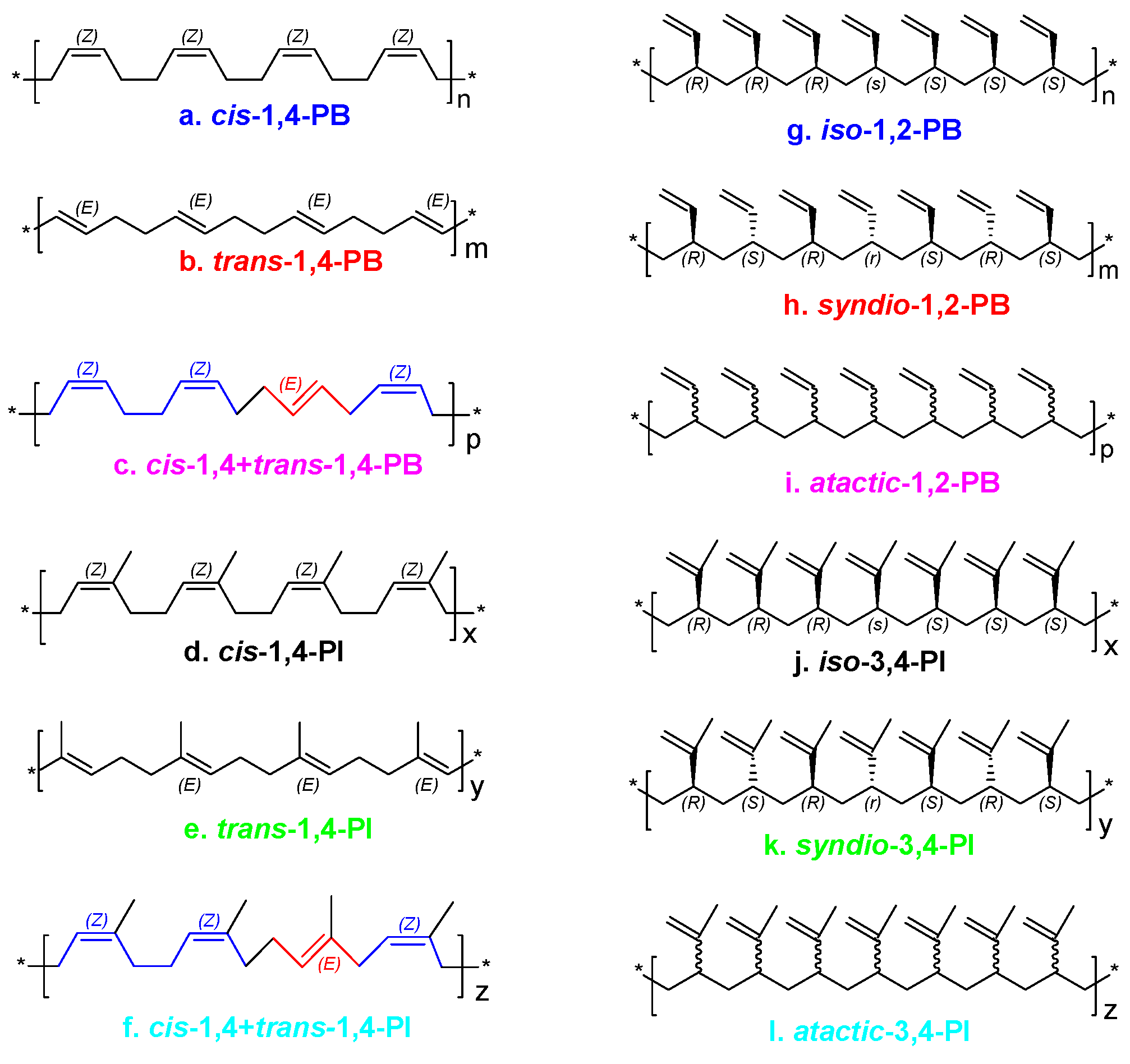

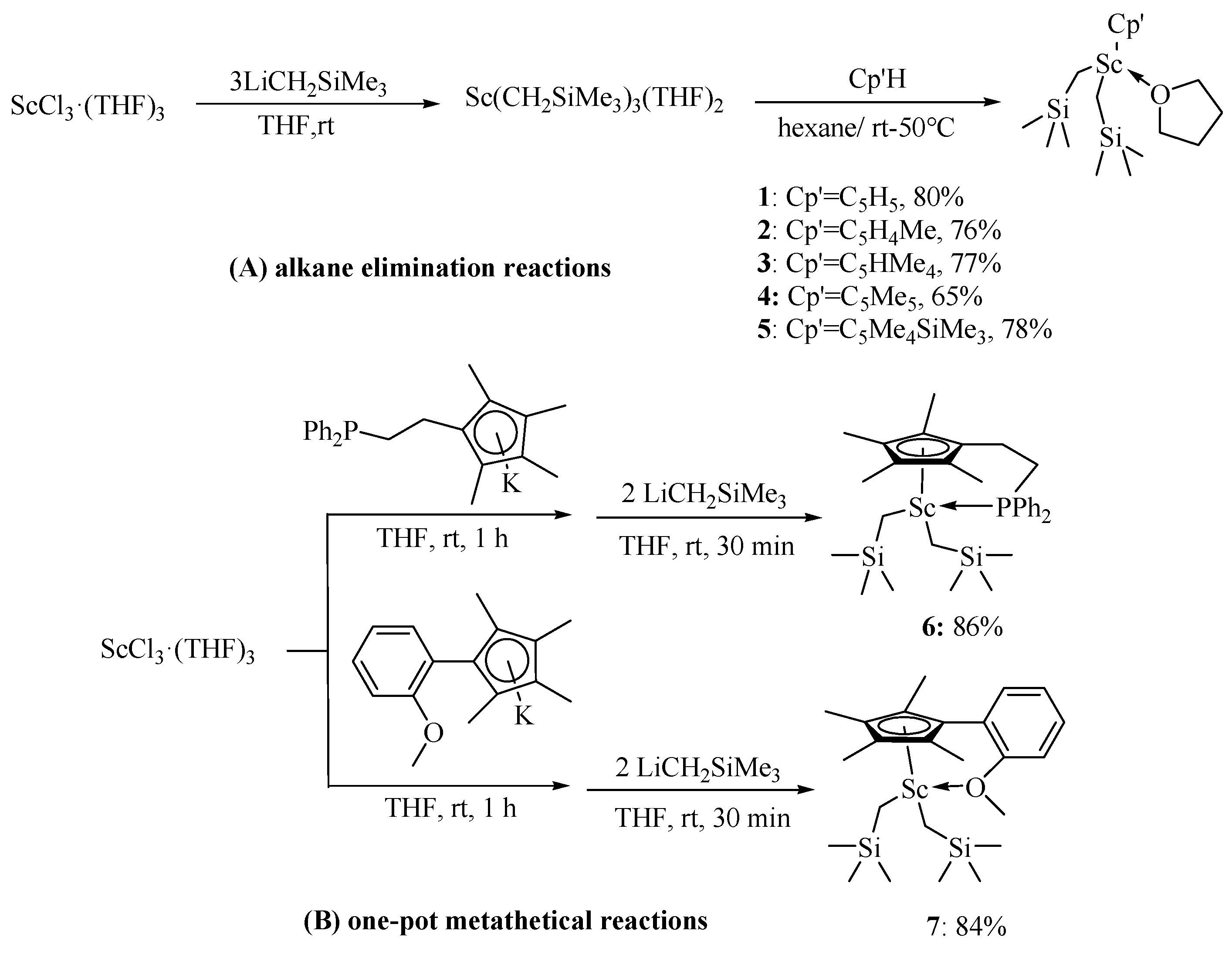

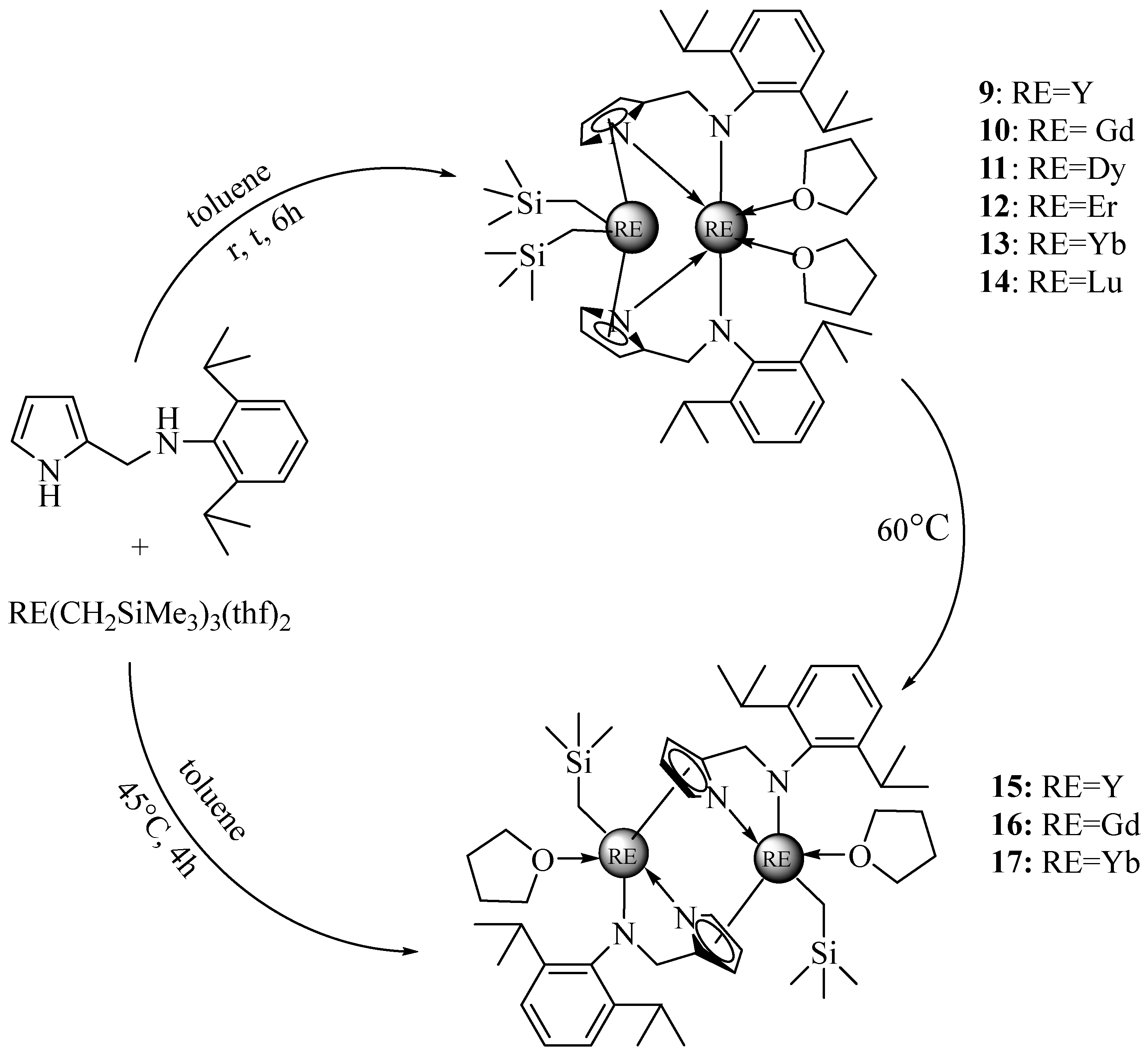
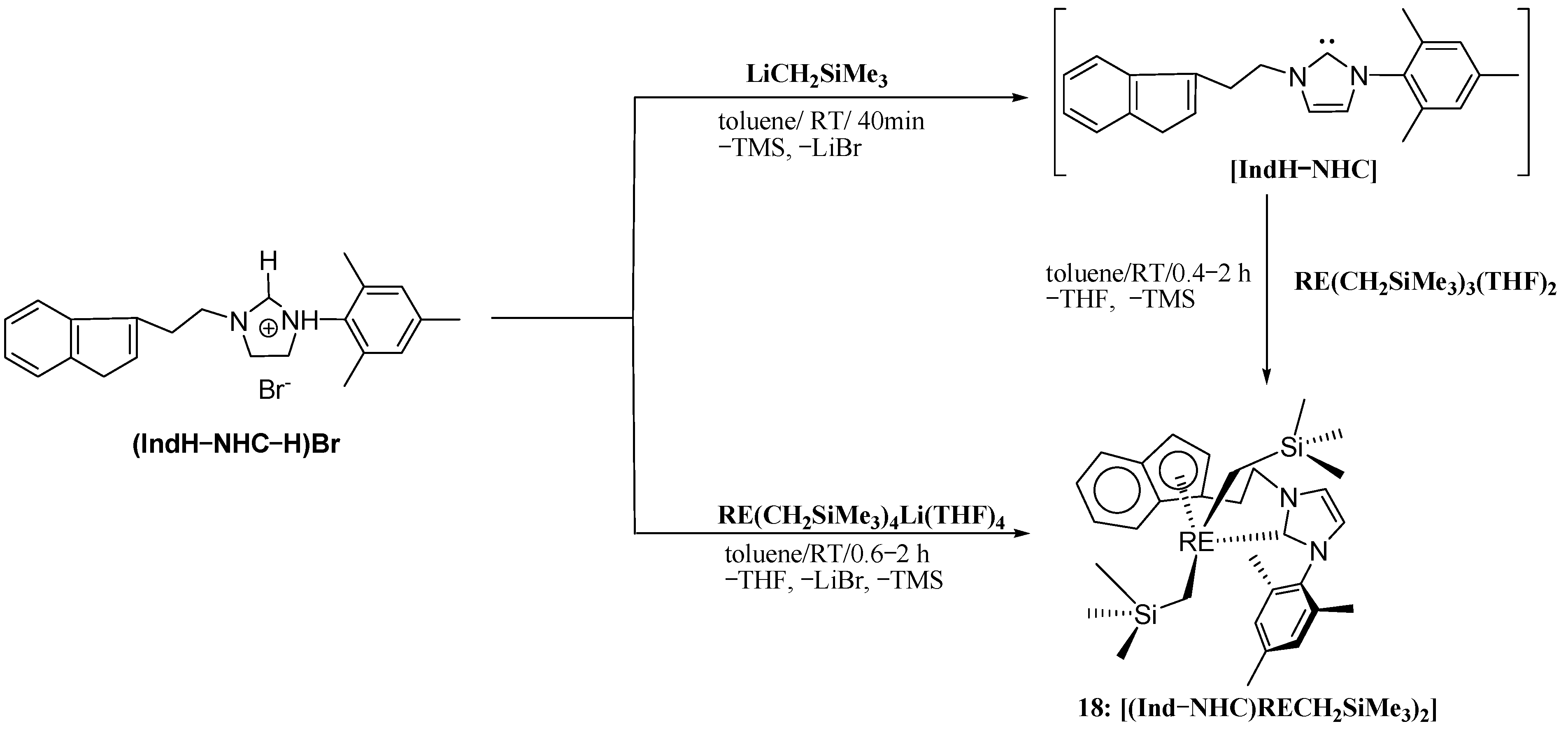
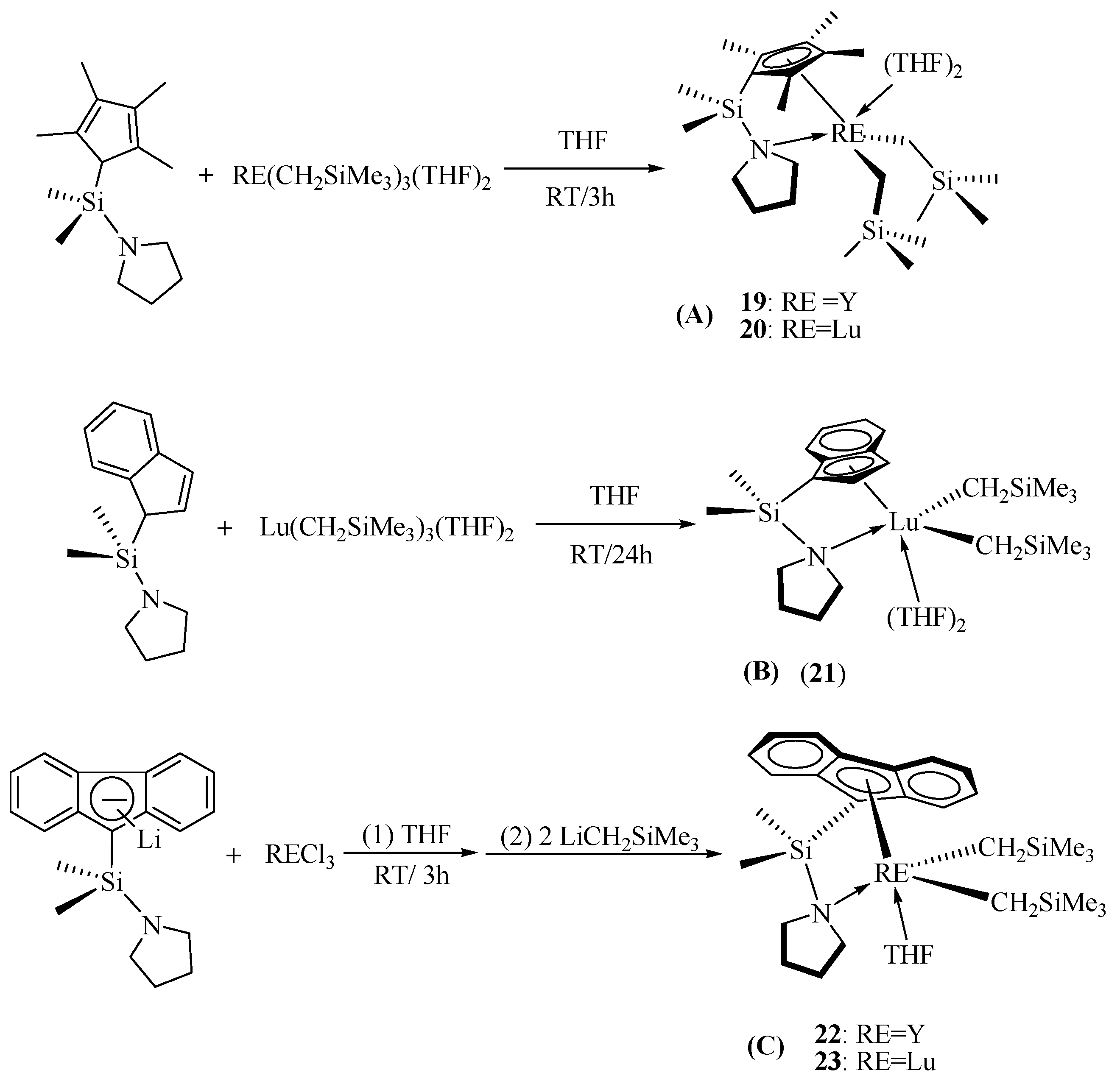
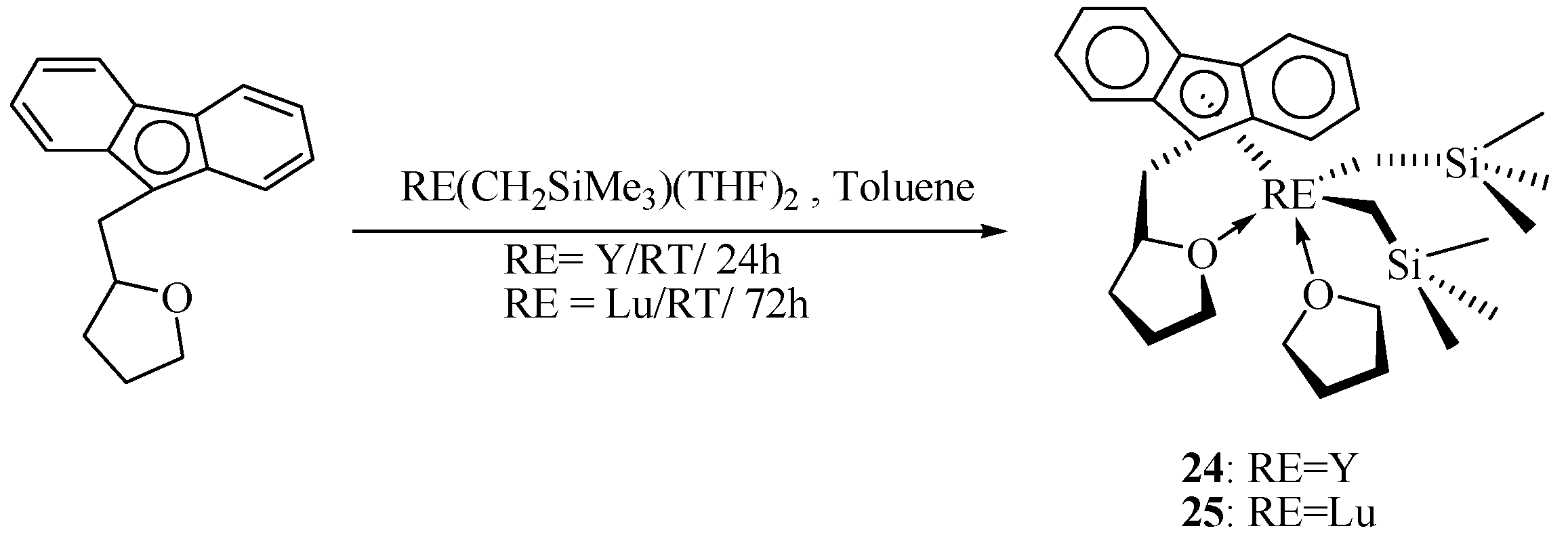
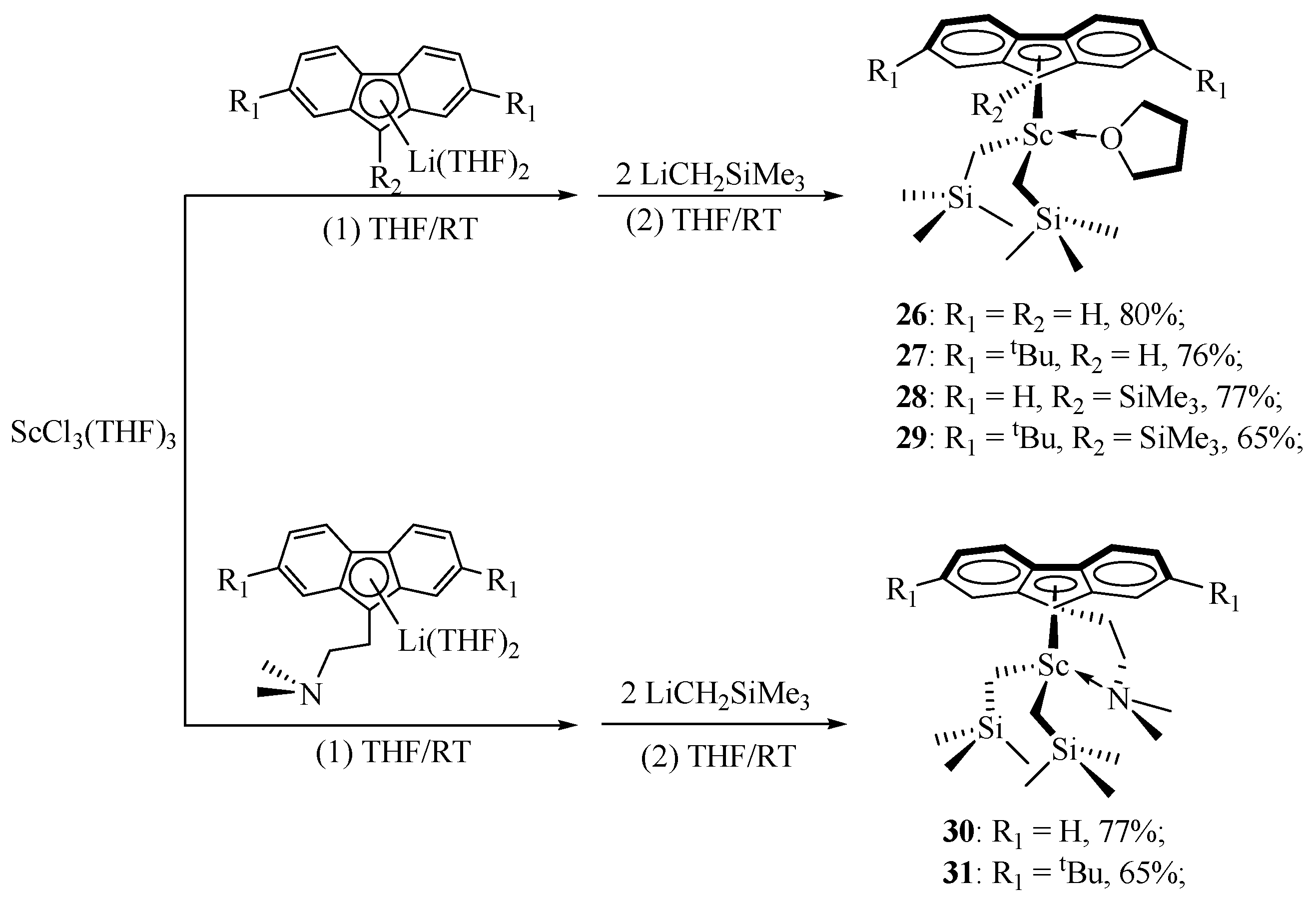

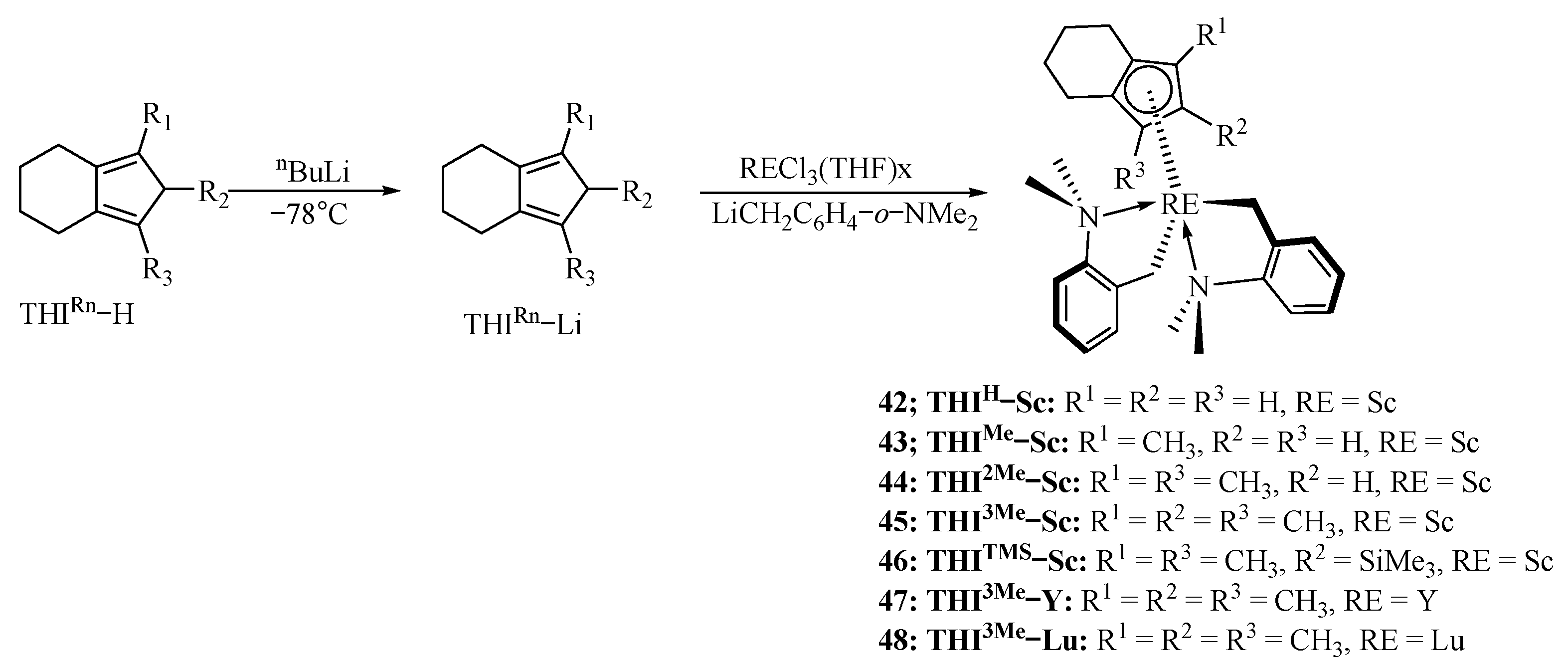
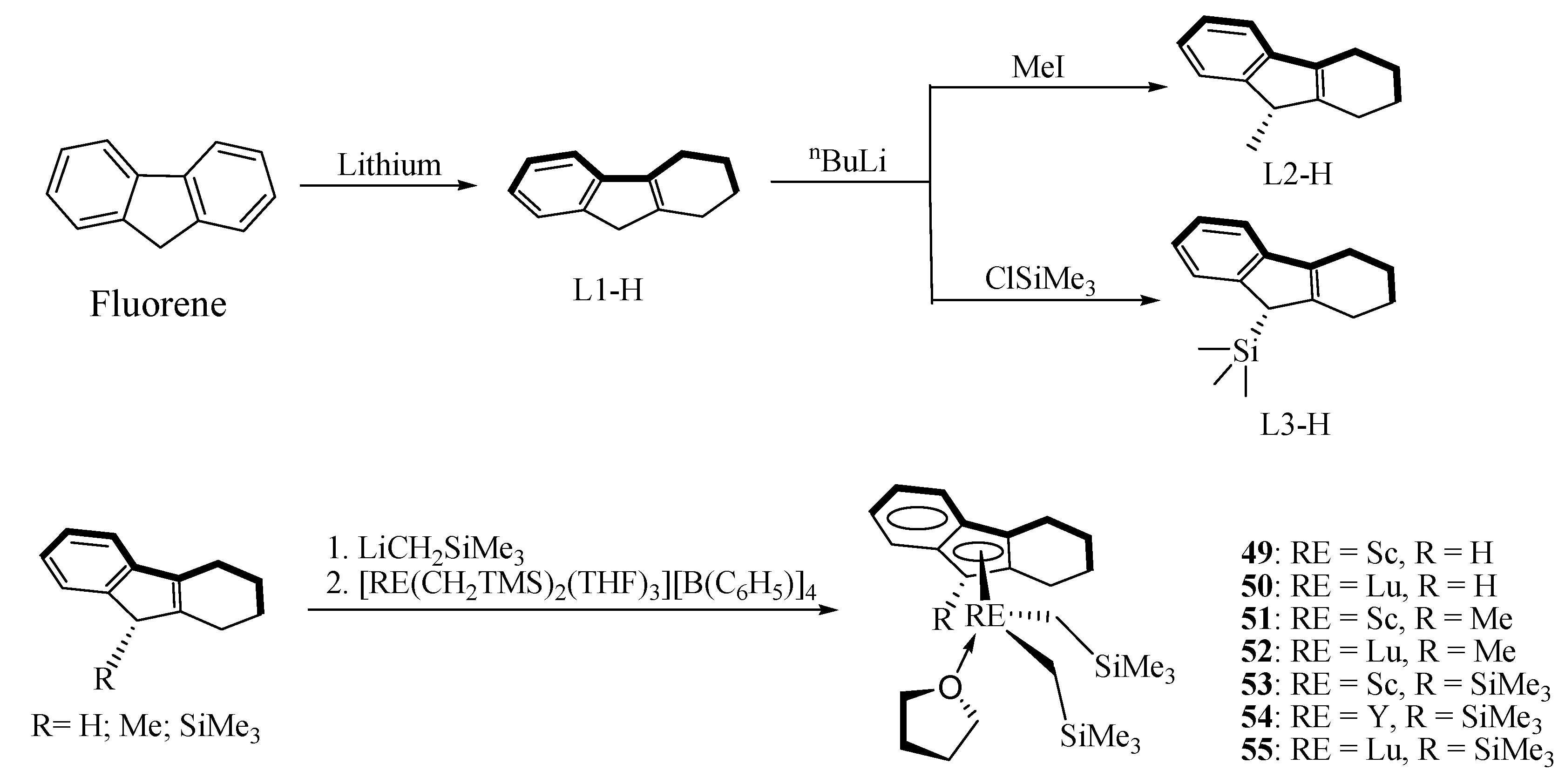

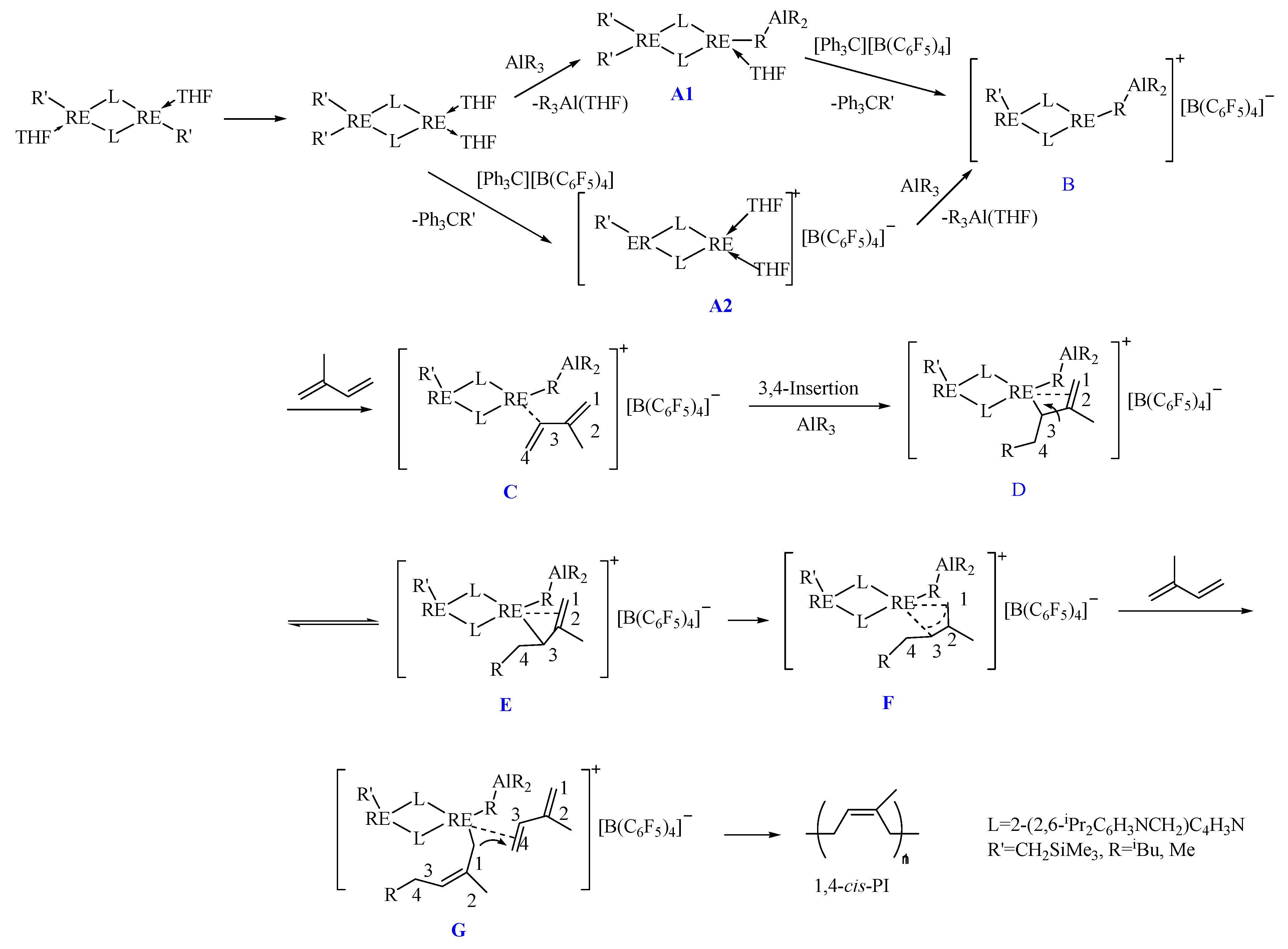


| Atomic Number | Rare-Earth Element | Electronic Configuration | Natural Abundance (ppm) | Price of Re2O3 (Millions USD/Ton) |
|---|---|---|---|---|
| 21 | Scandium (Sc) | [Ar]3d14S2 | 22 | 0.84 |
| 39 | Yttrium (Y) | [Kr]4d15s2 | 30 | 0.06 |
| 57 | Lanthanum (La) | [Xe]5d16s2 | 32 | 0.006 |
| 58 | Cerium (Ce) | [Xe]4f15d16s2 | 68 | 0.01 |
| 59 | Praseodymium (Pr) | [Xe]4f36s2 | 9.5 | 0.058 |
| 60 | Neodymium (Nd) | [Xe]4f46s2 | 38 | 0.056 |
| 61 | Promethium (Pm) | [Xe]4f56S2 | --- | --- |
| 62 | Samarium (Sm) | [Xe]4f66S2 | 7.9 | 0.02 |
| 63 | Europium (Eu) | [Xe]4f76S2 | 2.1 | 0.027 |
| 64 | Gadolinium (Gd) | [Xe]4f75d16s2 | 7.7 | 0.025 |
| 65 | Terbium (Tb) | [Xe]4f96s2 | 0.48 | 0.82 |
| 66 | Dysprosium (Dy) | [Xe]4f106s2 | 6 | 0.22 |
| 67 | Holmium (Ho) | [Xe]4f116s2 | 1.4 | 0.066 |
| 68 | Erbium (Er) | [Xe]4f126S2 | 3.8 | 0.04 |
| 69 | Thulium (Tm) | [Xe]4f136S2 | 0.48 | 0.19 |
| 70 | Ytterbium (Yb) | [Xe]4f146S2 | 3.3 | 0.014 |
| 71 | Lutetium (Lu) | [Xe]4f14d16S2 | 0.51 | 0.71 |
Disclaimer/Publisher’s Note: The statements, opinions and data contained in all publications are solely those of the individual author(s) and contributor(s) and not of MDPI and/or the editor(s). MDPI and/or the editor(s) disclaim responsibility for any injury to people or property resulting from any ideas, methods, instructions or products referred to in the content. |
© 2025 by the authors. Licensee MDPI, Basel, Switzerland. This article is an open access article distributed under the terms and conditions of the Creative Commons Attribution (CC BY) license (https://creativecommons.org/licenses/by/4.0/).
Share and Cite
Kang, D.; Ma, R.; Hu, H.; Zhou, Y.; Mao, G.; Xin, S. Advances in Half-Sandwich Rare-Earth Catalysts for Conjugated Dienes Polymerization. Catalysts 2025, 15, 569. https://doi.org/10.3390/catal15060569
Kang D, Ma R, Hu H, Zhou Y, Mao G, Xin S. Advances in Half-Sandwich Rare-Earth Catalysts for Conjugated Dienes Polymerization. Catalysts. 2025; 15(6):569. https://doi.org/10.3390/catal15060569
Chicago/Turabian StyleKang, Di, Rongqing Ma, Hongfan Hu, Yi Zhou, Guoliang Mao, and Shixuan Xin. 2025. "Advances in Half-Sandwich Rare-Earth Catalysts for Conjugated Dienes Polymerization" Catalysts 15, no. 6: 569. https://doi.org/10.3390/catal15060569
APA StyleKang, D., Ma, R., Hu, H., Zhou, Y., Mao, G., & Xin, S. (2025). Advances in Half-Sandwich Rare-Earth Catalysts for Conjugated Dienes Polymerization. Catalysts, 15(6), 569. https://doi.org/10.3390/catal15060569







